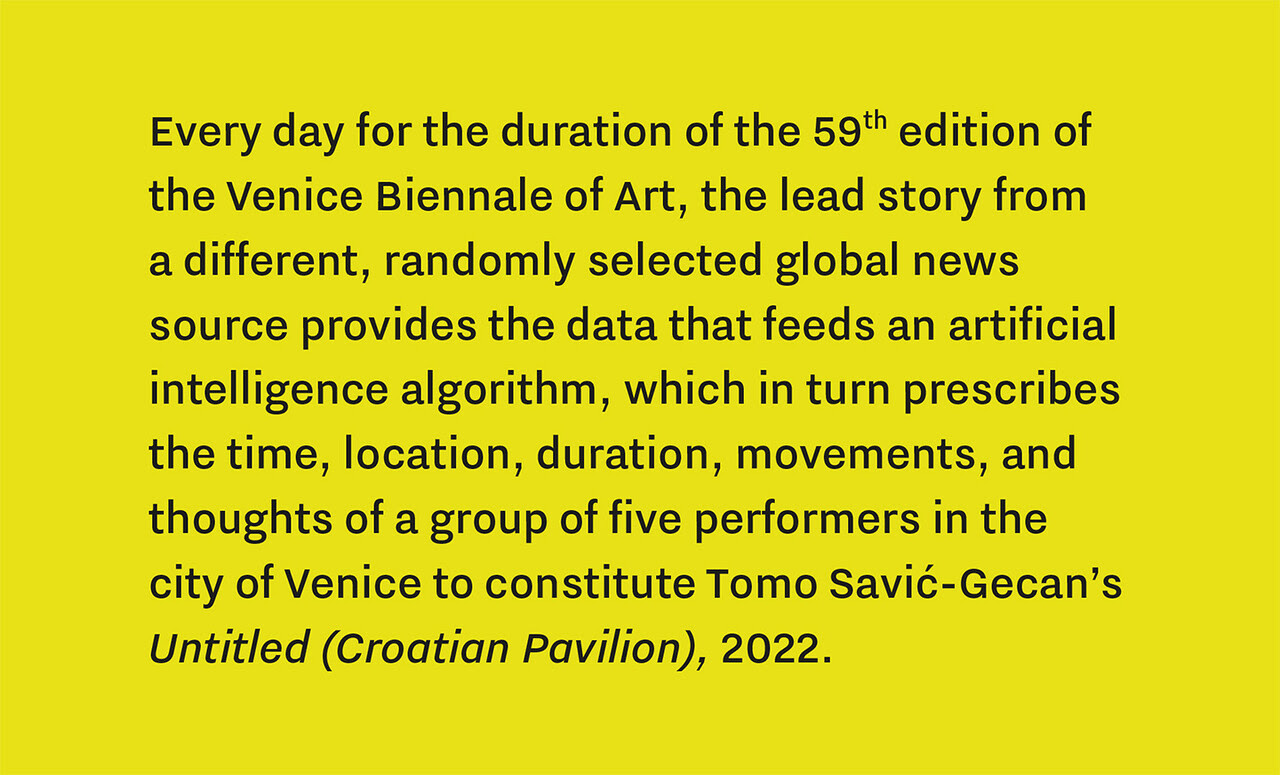59. Biennale – Padiglione Croato

Tomo Savić-Gecan rappresenta la Croazia alla Biennale di Venezia col progetto
Comunicato stampa
Tomo Savić-Gecan
Untitled (Croatian Pavilion)
April 23–November 27, 2022
Opening: April 22, 1pm
Castello, via Garibaldi 1513, Venice, Italy
Add to Calendar
www.croatianpavilion2022.com
New viral infection rates, a war in Ukraine, supposed election manipulations, a Kardashian divorce, ecological catastrophes, the rise and fall of cryptocurrencies, one more political corruption scandal: there is no escaping the news. Global networked information flows penetrate practically every aspect of our daily lives. Simultaneously, an ever-increasing number of technological systems effectively guarantee the public burial of objective facts under an avalanche of rumor, emotion, and personal belief, even as our relationship to these is tracked and mined, predicted and modified. In the context of this total condition, Tomo Savić-Gecan’s Untitled (Croatian Pavilion), 2022, is an artwork conceived in and for a “post-truth” era.
The practical functioning of the project could be described as follows: an artificial intelligence daily analyzes textual data from the lead article of a randomly selected major news source, such as Arab News, Corriere della Sera, El Tiempo, Le Monde, The Bangkok Post, The Namibian, The New York Times, etc. This AI is trained to recognize and classify a defined set of topics, spanning from climate change to violations of human rights, and from developments in technology to military movements. The result produces a set of algorithmically-derived instructions for a group of five performers: the start time, duration, exact location, and all the choreographic details of each of their variable number of performances for that day. The media-derived data’s grid coordinates determine which of the various national pavilions inside and outside the Giardini the performers will infiltrate at any given time. It furthermore defines in what formation the performers enter or leave a space, what minimal movements they enact, and it even prescribes what they should think about while performing. These instructions change, as the news changes, every day for the seven months of the Biennial.
The performers will be present wherever the AI system directs them. Visitors, too, should they want to view the piece, will effectively have to follow the lead of this same “intelligence,” with updates shared on the pavilion’s official website or at an information hub located on the via Garibaldi. Still, the piece may well elude the casual observer: the five performers will not speak or carry props and will not wear any costume or badge or other signifier, thus there will be no outward difference between them and members of the audience, no spectacle of any kind. The performers’ actions might only become legible when enacted synchronously and against the backdrop of a crowd of others who move randomly and according to their own free volition. Untitled (Croatian Pavilion) uses the sparest of movements and means to leave an impression that ever so slightly troubles our experience of the otherwise ordinary.
The artist’s decision to use the news as a starting point is not incidental: the experience of the publicly performed artwork will be a reflection of what is going on in the world, who reports on it, and how. Yet, regardless of the specific subject matter to which the artist’s project turns (the movement of Russian troops, a Chinese hacker scandal), the project’s actual subject is how we are informed about our present, and how we are literally formed by the stories we are sold. And, because the media, as well as the systems through which it circulates, are arguably machines for disciplining citizens, organizing perception, extracting profit, and articulating ideology, it is only fitting that these determine every aspect governing Untitled (Croatian Pavilion). Just as lives are transformed into data in the “real world,” generating new forms of social control, so, too, does this artwork transform the news into directives, mimicking the quiet insidiousness with which technology advances what scholar Shoshana Zuboff has called “surveillance capitalism.” As such, Savić-Gecan’s project is devastatingly topical, pointing to our complex relationship with the media, control, and power in the digital age.
—Elena Filipovic, Curator of the Croatian Pavilion
A catalog with contributions by Rahel Aima, Elena Filipovic, GTP-3, Vladan Joler, Olga Majcen Linn & Darko Šimičić, and Tomislav Medak, designed by Igor Kuduz, will be published by Sternberg Press and KONTEJNER.
Commissioned by: Ministry of Culture and Media of the Republic of Croatia – Nina Obuljen Koržinek, minister; Nevena Tudor Perković, director of Directorate for Cultural and Artistic Development
Curated by: Elena Filipovic
Organized and produced by: KONTEJNER | bureau of contemporary art praxis – Olga Majcen Linn, Tereza Teklić
Collaborators: Irma Omerzo (choreographic production lead), Tomislav Pokrajčić (technical production lead) with Jan Šnajder, Ana Barić, and Sara Bakić (AI team – TakeLab, Faculty of Electrical Engineering and Computing, University of Zagreb)
Producer (in Venice): Diego Carpentiero
Supported by: Mato Perić and the Perić Collection, Mondriaan Fonds, the Ministry of Science and Education of the Republic of Croatia, and Zagreb Tourist Board. The project was additionally supported through a residency with the Art Explora Foundation, Paris.
Media Contacts: [email protected] (International), [email protected] (Croatia)



